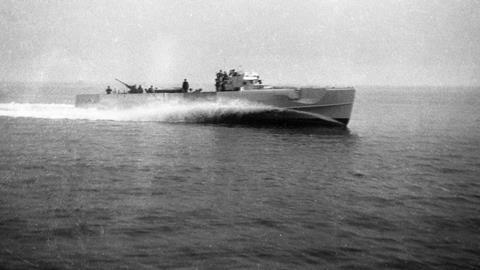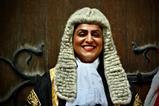Eighty years ago this month, a desperate night battle was taking place off the coast of Cherbourg. British and German high-speed gunboats clashed in a fight which culminated, in the gung-ho words of an official statement, with 'German E boats fighting each other under fire from their own shore batteries'. The Gazette's report continued: 'In this action, two [German] E boats were set on fire from stem to stern, two others were damaged, and hits were scored on two 600-ton torpedo boats.’
The Gazette noted the battle because the British flotilla was commanded by a Falmouth solicitor, Lieutenant Commander Robert Peverell Hichens, Royal Navy Volunteer Reserve. Hichens was to become the most decorated member of a remarkable corps - the thousands of civilian yachtsmen who served as temporary naval officers in the war. It was a band in which the legal profession was disproportionately represented. Lawyer yachtsmen-turned-naval-officers defused mines, commanded ships, sank U-boats, and ferried agents across the Channel and North Sea. At least one such officer provided part of the composite character of James Bond as created by Ian Fleming - himself an RNVR officer.
In the middle years of the war, hardly an issue of the Gazette appeared without one such volunteer being mentioned in the Honour and Awards column - or in the monthly Roll of Honour. A typical entry, from July 1942, read: 'Humble-Smith, Roger Rodwell, Sub-Lt, RNVR, missing, presumed killed on HM Trawler Notts County. Articled to F.K. East, Boscombe.'
The RNVR was created in 1903 and, unlike the 'regular' Royal Naval Reserve, was open to men with no professional nautical background. In 1936 it was supplemented by the Royal Naval Volunteer Supplementary Reserve (RNVSR), whose approach to recruitment was summed by by a 1940 advertisement in The Times inviting 'Gentlemen with yachting experience' to apply for commissions as temporary probationary sub-lieutenants.
Hichens, known as 'Hitch', joined the RNVSR on its formation, transferring from the territorial army. He been admitted in 1933 and was partner in the Falmouth firm of Reginald Rogers & Son. His pre-war passions were sailing and motor racing: he competed three times in the Le Mans 24-hour race in a two-litre Aston Martin.
Wearing the 'wavy navy' insignia of the Royal Navy reserve, Hitch exemplified the Nelsonian maxim 'engage the enemy more closely'. At Dunkirk, when the destroyer in which he was serving was ordered home, he volunteered to remain ashore to supervise the army's evacuation into small boats. He eventually made it back in a yacht, to be awarded the Distinguished Service Cross.
He transferred to the high-speed gunboats of the coastal forces: spartan plywood-hulled craft propelled by multiple petrol-fuelled aircraft engines. Today they would be regarded as dicey for summer cruising - let along year-round operational sorties facing enemy fire, mines and bombs.
In March 1942, the Gazette reported that Hichens had been awarded a bar to his DSC 'for coolness, skill, and steadiness when our naval patrols and light coastal forces went into action against enemy E boards, sinking three and damaging others'. It was one of a string of actions in which Hitch distinguished himself, though, as Julia Jones notes in an excellent new history*, at a terrible cost to his nerves.
Yachting lawers were to serve far beyond the coastal forces. The most gruelling draft may have been in corvettes escorting the Atlantic convoys. The experience was immortalised by Nicholas Monserrat in The Cruel Sea - which, apart from its graphic depictions of the horrors of war at sea, indicated some of the tensions that arose when volunteers and regular officers shared a wardroom. Monsarrat, a Cambridge law graduate, had trained as an articled clerk with the Nottingham firm of Acton, Marriot and Simpson (its successor practice, Actons, is still very much around), before deciding to become a novelist. He had yet to make a name for himself when the war intervened: he served for six years, ending the war in command of a frigate - a promotion that would have been unthinkable at the outset.
In October 1942, the Gazette referred to one of the war's most bitter convoy battles, Operation Pedestal, when it noted that Lt Kenneth Kirkland Lacey RNVR had been mentioned in dispatches 'for gallantry, skill and seamanship in the recent action against strong enemy forces which resulted in the safety passage to Malta of an important convoy'. It continued: 'This is the third occasion in which he has been mentioned in despatches. He is articled to his father, Mr GN Lacey of 38 Lincoln’s Inn Fields, WC.'
Other yachtsman lawyers served in anything from mine-sweeping trawlers to battleships. However a big ship berth was not necessarily a safe one: in January 1942 the Gazette recorded that Lt Benjamin Rhodes Armitage, RNVR, previously reported missing, is 'now known to have lost his life' in the sinking of HMS Prince of Wales by Japanese torpedo planes off Singapore.
Back in the small boats, French-speaking Dunstan Curtis, admitted in 1937, found himself running a clandestine shuttle service carrying secret agents between Cornwall and Brittany. Another solicitor, Peter Williams, made an overnight crossing in early 1944, creeping up to the treacherous tide-ripped coast in the dark - a task few modern yacht skippers would relish in February - to land a party which included Francois Mitterrand, future president of France.
Curtis had an extraordinary career. As a member of Ian Fleming's special assault unit, set up to capture enemy technology and information, he won the DSC for his part in the 1942 St Nazaire raid, in which the plywood gunboats were pitted against German shore batteries. He also took part in the Dieppe raid, the capture of Algiers - and led a force onto the Normandy beach on D-Day+1. In the final days of the war, while taking control of the Blohm & Voss engineering works in Kiel, Curtis accepted the surrender of the city. When Fleming was casting around for the ingredients of 007, he did not have far to look.
After the war, Curtis became a key figure in the European movement, helping to draft the European convention on human rights. He died in 1983.
Alas Hitch Hichens never returned to peacetime practice. On the night of 12/13 April 1943, he was killed in an engagement while escorting mine-layers off the Dutch coast. He received a further posthumous mention in despatches, and was recommended for the Victoria Cross. His entry in the Gazette’s Roll of Honour (May 1943) merely states he was ‘killed in action’. He was 34.
Nearly a century on, we who go down to the sea in small ships - some of us via the Law Society Yacht Club - can only look back with admiration and respect. And with gratitude that we have never been called upon to show if we could match the feats of our forerunners 'with yachting experience'.
Further reading
- *Uncommon Courage: The Yachtsman Volunteers of WWII, Julia Jones, Bloomsbury 2022
- We Fought them in Gunboats, Robert Peverell Hichens, Michael Joseph 1944
- Wartime back-numbers of the Gazette are available to read at the Law Society library



































4 Readers' comments